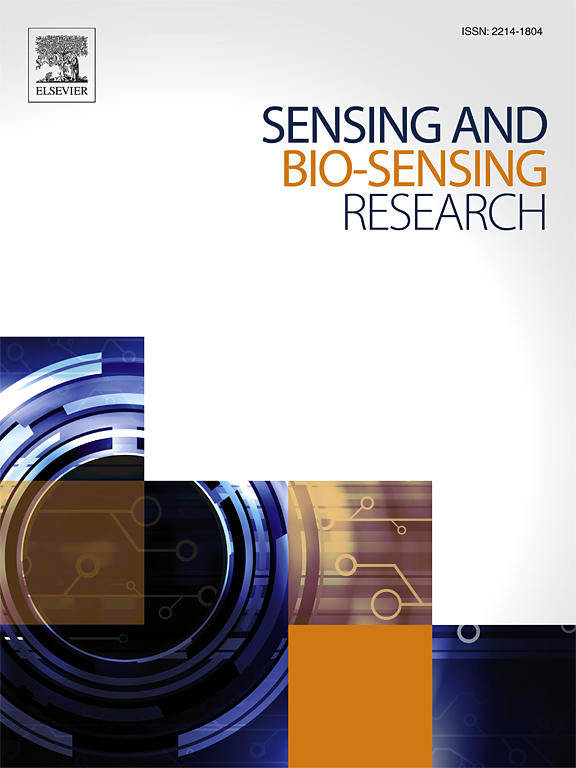Surface acoustic waves (SAW) sensor for the active detection of Microcystin-LR (Cyanobacteria)
IF 4.9
Q1 CHEMISTRY, ANALYTICAL
引用次数: 0
Abstract
Cyanobacteria are a family of prokaryotic bacteria whose death causes the release of harmful toxins. Upon ingestion, these toxins produce symptoms similar to food poisoning and are dangerous to humans, as well as livestock. As there is no easily accessible way to remove cyanotoxins from water sources, thus detection before consumption is vitally important. In this article, we report a shear horizontal surface acoustic wave (SH-SAW) based sensor for the active detection of the microcystin congener, microcystin-LR (MC-LR). The sensing platform was devised on 36° YX cut-LiTaO3 which is a piezoelectric substrate. The sensor system was designed based on delay line configuration and was actively coated with silicon dioxide as a waveguide layer for better mass-load sensitivity. Unlike conventional SAW, the sensing platform utilizes a 5-count tone burst signal, enhancing sensitivity due to its sensitive coda waves. Signal transformation and analysis were made for distinct detection in the frequency domain. The sensor also incorporates the functionalization of gold nanospheres for a high surface-to-volume ratio and enhanced degree of orientation leading to better sensitivity. The sensor detection limit was down to 5.13 nM. Further evidence was provided by selectivity analysis and the sensor could identify MC-LR from the other biomarkers.
表面声波(SAW)传感器主动检测微囊藻毒素lr(蓝藻)
蓝藻是一种原核细菌,其死亡会导致有害毒素的释放。摄入这些毒素后,会产生类似食物中毒的症状,对人类和牲畜都有危险。由于没有容易获得的方法从水源中去除蓝藻毒素,因此在消费前进行检测至关重要。在本文中,我们报道了一种基于剪切水平表面声波(SH-SAW)的传感器,用于主动检测微囊藻毒素同属物微囊藻毒素lr (MC-LR)。传感平台设计在36°YX型压电基板上。传感器系统基于延迟线结构设计,并主动涂覆二氧化硅作为波导层,以获得更好的质量负载灵敏度。与传统声表面波不同,传感平台利用5计数音突发信号,由于其灵敏的尾波,提高了灵敏度。对信号进行变换和分析,在频域上进行明显检测。该传感器还结合了金纳米球的功能化,具有高表面体积比和增强的取向度,从而提高了灵敏度。传感器检测限降至5.13 nM。选择性分析提供了进一步的证据,该传感器可以从其他生物标志物中识别出MC-LR。
本文章由计算机程序翻译,如有差异,请以英文原文为准。
求助全文
约1分钟内获得全文
求助全文
来源期刊

Sensing and Bio-Sensing Research
Engineering-Electrical and Electronic Engineering
CiteScore
10.70
自引率
3.80%
发文量
68
审稿时长
87 days
期刊介绍:
Sensing and Bio-Sensing Research is an open access journal dedicated to the research, design, development, and application of bio-sensing and sensing technologies. The editors will accept research papers, reviews, field trials, and validation studies that are of significant relevance. These submissions should describe new concepts, enhance understanding of the field, or offer insights into the practical application, manufacturing, and commercialization of bio-sensing and sensing technologies.
The journal covers a wide range of topics, including sensing principles and mechanisms, new materials development for transducers and recognition components, fabrication technology, and various types of sensors such as optical, electrochemical, mass-sensitive, gas, biosensors, and more. It also includes environmental, process control, and biomedical applications, signal processing, chemometrics, optoelectronic, mechanical, thermal, and magnetic sensors, as well as interface electronics. Additionally, it covers sensor systems and applications, µTAS (Micro Total Analysis Systems), development of solid-state devices for transducing physical signals, and analytical devices incorporating biological materials.
 求助内容:
求助内容: 应助结果提醒方式:
应助结果提醒方式:


